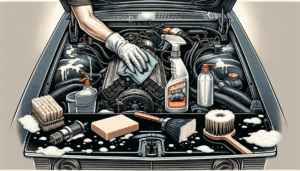You’re in luck! If you’ve been battling stubborn stains and odors in your vehicle or boat, look no further. Ace Mobile Detailing is here to share their top 9 tips for tackling these pesky problems. Based in Orange Beach, AL, Ace Mobile Detailing is a licensed and insured professional company that specializes in automotive, boat, RV, and aircraft detailing, as well as ceramic coatings. With their expertise and the best products on the market, they are dedicated to making sure your vehicle or boat looks its absolute best. So, let’s dive right in and discover these top 9 tips for removing stubborn stains and odors!
Preventing Stains and Odors
Stains and odors can be a hassle to deal with, but with some preventative measures, you can minimize their occurrence. One of the simplest ways to prevent stains is by cleaning up spills immediately. Whether it’s a glass of red wine or a cup of coffee, the faster you act, the better chance you have of preventing a stain from setting in. Grab a clean cloth or paper towel and gently blot the spill, being careful not to rub it in.
Another method of preventing stains is by using protective covers. Whether it’s a slipcover for your couch or a waterproof mattress protector, these covers act as a barrier between your furniture and any potential spills. They are especially useful if you have children or pets who may be prone to accidents.
Speaking of pets, keeping them off the furniture is another effective way to prevent stains and odors. We all love our furry friends, but their accidents or drool can leave unsightly stains and unpleasant odors. Train your pets to stay off the furniture, or designate certain areas where they are allowed. If you do allow them on the furniture, consider using a pet-friendly cover that is easy to clean.
Proper ventilation is crucial in preventing odors from lingering in your space. Whether it’s cooking smells or musty odors, opening windows and doors can help circulate fresh air and eliminate trapped odors. Additionally, using fans or air purifiers can help improve air quality and reduce unpleasant odors.
Removing Food and Beverage Stains
Accidents happen, and sometimes spills and stains are inevitable. But with the right techniques, you can effectively remove food and beverage stains from your fabrics. The first step is to blot the stain as soon as possible. Use a clean cloth or paper towel to gently blot the stain, starting from the outside and working your way in. Avoid rubbing the stain, as this can push it deeper into the fabric.
After blotting, treat the stain with a stain remover. There are numerous commercial stain removers available, but you can also make your own by mixing equal parts water and dishwashing detergent. Apply the stain remover to the stained area and let it sit for a few minutes.
For stubborn stains, a mixture of vinegar and water can be highly effective. Mix equal parts white vinegar and water and apply it to the stain. Let it sit for a few minutes before blotting it with a clean cloth. Be sure to test this solution in an inconspicuous area first to ensure it doesn’t cause any damage or discoloration.
If the stain still persists, you can try applying a baking soda paste. Mix baking soda with water until you achieve a paste-like consistency. Apply the paste to the stain and let it dry. Once dry, vacuum or brush off the baking soda residue. This method can be especially useful for removing stubborn stains from carpets and upholstery.

Eliminating Pet Odors
Pets bring joy to our lives, but they can also leave behind unwanted odors. Whether it’s urine or pet odors, here are some tips for effectively eliminating them. If there is solid waste present, it’s crucial to remove it immediately. Use gloves or a clean plastic bag to pick up the waste and dispose of it properly.
For urine accidents, quickly soak up the urine with paper towels or a clean cloth. Blot the area gently, being careful not to spread the urine further. Once most of the urine is absorbed, apply an enzymatic pet odor neutralizer. These products contain enzymes that break down the organic compounds in urine, effectively eliminating odors.
If you have carpets, sprinkle baking soda over the affected area and let it sit for at least 15 minutes. The baking soda will help absorb any remaining odors. Once the time is up, vacuum the area thoroughly to remove the baking soda and any trapped odors.
It’s important to take proactive steps to prevent future accidents and odors. If your pet is not already trained, consider investing time in proper training to prevent future accidents. Additionally, regularly clean and groom your pets to minimize odors and dander buildup.
Getting Rid of Smoke Smells
Smoke smells can be particularly challenging to eliminate, but with the right techniques, you can successfully freshen up your space. Start by opening windows and doors to allow fresh air in and allow the smoky air to escape. This can make a significant difference in improving air circulation and reducing odors.
For upholstery that has absorbed smoke odors, clean it with a fabric freshener. Look for a product specifically designed to eliminate odors rather than simply masking them. Follow the instructions on the fabric freshener and be sure to test it in a small, inconspicuous area first to check for any adverse reactions.
To further absorb odors, you can use an odor-absorbing gel. These gels are designed to trap and neutralize odors in the air. Place a few jars or containers of the gel around the room, making sure they are out of reach of children and pets.
Another effective method for eliminating smoke smells is to place bowls of vinegar around the room. Vinegar has natural odor-absorbing properties and can help neutralize smoke odors. Leave the bowls of vinegar out overnight or for a few days, then discard the vinegar and thoroughly ventilate the space.

Treating Mildew and Mold Stains
Mildew and mold stains not only look unsightly but can also pose health risks. When dealing with these stains, it’s important to take precautions and wear protective gear, such as gloves, a mask, and safety goggles. This will help safeguard your health while working with potentially harmful substances.
To remove mildew and mold stains, start by scrubbing the affected area with a bleach solution. Mix one part bleach with three parts water and apply it to the stain. Scrub the area gently but thoroughly to ensure you remove all traces of mold or mildew. Rinse the area with clean water and allow it to dry completely.
If the bleach solution doesn’t completely remove the stains, you can use a specialized mold and mildew remover. These products are designed specifically to eliminate mold and mildew stains and can be highly effective. Follow the instructions on the product carefully and ensure proper ventilation during the application process.
To prevent regrowth, it’s crucial to ensure proper ventilation in the affected area. Mold and mildew thrive in damp, poorly ventilated spaces, so consider using fans or dehumidifiers to keep the area dry. Regularly inspect your home for any signs of moisture or water leaks, as these can contribute to the growth of mold and mildew.
Removing Grease and Oil Stains
Grease and oil stains can be stubborn and challenging to remove, but with the right approach, you can tackle them effectively. The first step is to blot up any excess grease or oil using a clean cloth or paper towel. Gently press the cloth against the stain, absorbing as much of the grease or oil as possible.
Next, cover the stain with cornstarch or baking soda. These powders help absorb the grease or oil, making it easier to remove. Sprinkle a generous amount of cornstarch or baking soda over the stain, ensuring it is completely covered. Let it sit for a few minutes to allow the powder to work its magic.
After the powder has absorbed the grease or oil, apply dishwashing detergent directly to the stain. Use a clean cloth or brush to gently scrub the area in circular motions. The dishwashing detergent will break down the grease or oil, making it easier to remove. Rinse the area with clean water and check if the stain is still visible.
If the stain persists, you can use a degreasing spray. These sprays are specially formulated to remove grease and oil stains and can be highly effective. Follow the instructions on the product and be sure to test it in an inconspicuous area first to avoid any potential damage to the fabric.
Tackling Urine Odors
Urine odors can be quite unpleasant, but with the right techniques, you can effectively eliminate them. Start by blotting up any excess urine with a clean cloth or paper towel. Gently press the cloth against the stain, absorbing as much urine as possible. Avoid rubbing the urine, as this can spread it further.
Next, make a solution with hydrogen peroxide and dish soap. Mix equal parts hydrogen peroxide and dish soap in a bowl. Using a clean cloth or sponge, apply the solution to the affected area. Be sure to wear gloves to protect your skin. Gently scrub the area in circular motions, ensuring the solution penetrates the fabric.
After applying the solution, sprinkle baking soda over the affected area. Baking soda is a natural deodorizer and can help neutralize any remaining urine odors. Let the baking soda sit for at least 15 minutes to absorb the odors. Once the time is up, vacuum the area thoroughly to remove the baking soda and any trapped odors.
Regularly cleaning your carpets and upholstery can help prevent urine odors from becoming ingrained. Consider using a carpet cleaner or hiring a professional cleaning service to deep clean your fabrics on a regular basis. This will help remove any lingering odors and keep your home smelling fresh.
Dealing with Ink and Dye Stains
Ink and dye stains can be particularly tricky to remove, but with the right techniques, you can minimize their impact. The key is to act quickly and blot the stain as soon as possible. Use a clean cloth or paper towel to blot the stain, starting from the outside and working your way in. Avoid rubbing the stain, as this can spread it further.
Once you’ve blotted the stain, apply rubbing alcohol or nail polish remover to the affected area. These products contain solvents that can help break down the ink or dye. Use a clean cloth or sponge to gently blot the area, allowing the solvent to penetrate the fabric. Be sure to test the solvent in an inconspicuous area first to check for any adverse reactions.
After applying the solvent, rinse the area with cold water to remove any residue. Be sure to use cold water, as hot water can set the stain. Gently blot the area with a clean cloth to remove any excess moisture.
If the stain persists, you can use a stain-removing laundry detergent. Apply the detergent directly to the stain and let it sit for a few minutes. Then, launder the affected item according to the care instructions on the label. Check if the stain is completely removed before drying the item.
Removing Sweat and Body Odors
Sweat and body odors can cling to clothing and fabrics, but with a few tricks, you can effectively eliminate them. Before laundering your clothes, pre-treat them with laundry detergent. Apply a small amount of detergent directly to the affected areas, such as underarm stains or collar stains. Rub the detergent into the fabric and let it sit for a few minutes before washing.
Adding vinegar to the wash can also help eliminate sweat and body odors. Add half a cup of white vinegar to the washing machine drum along with your regular detergent. The vinegar will help break down the odors and leave your clothes smelling fresh. Be sure to check the care instructions on your garments, as vinegar may not be suitable for all fabrics.
Baking soda can be a natural deodorizer for clothes and fabrics. Sprinkle a generous amount of baking soda over your clothes before washing, paying particular attention to areas prone to sweat and body odor. Let the baking soda sit on the clothes overnight or for a few hours, then wash them as usual. The baking soda will help absorb any lingering odors, leaving your clothes smelling fresh.
After washing your clothes, it’s best to hang them to air dry rather than using a dryer. The heat from the dryer can set any remaining odors and make them more difficult to remove. Hang your clothes on a clothesline or drying rack and let them air dry completely. This will help ensure that any remaining odors are eliminated.
Keeping Fabrics Fresh
To keep your fabrics smelling fresh, there are a few simple tips you can follow. Sprinkling fabrics with baking soda is an effective way to eliminate odors. Whether it’s your couch, curtains, or rugs, sprinkle a thin layer of baking soda over the fabric and let it sit overnight. The baking soda will absorb any odors, leaving your fabrics smelling fresh. The next day, vacuum the fabric to remove the baking soda residue.
Fabric freshening sprays can also be a great option for keeping fabrics smelling pleasant. Look for sprays specifically designed for fabrics and follow the instructions on the label. These sprays can be used on curtains, upholstery, and even bedding to refresh the scent. Be sure to test the spray in an inconspicuous area first to check for any adverse reactions.
Finally, if weather permits, air out your fabrics in the sun. Sunlight has natural deodorizing properties and can help eliminate odors from fabrics. Hang your curtains, cushions, or blankets outside on a sunny day and let them bask in the sunlight. Not only will they freshen up, but they will also benefit from the natural disinfecting properties of the sun.
By following these tips and techniques, you can effectively prevent and eliminate stains and odors from your fabrics. Whether it’s a stubborn food stain, a lingering pet odor, or a smoky smell, these methods will help you keep your fabrics clean, fresh, and odor-free. Remember to always test any cleaning solution or product in an inconspicuous area before applying it to the entire stain or fabric. With a little effort and the right approach, your fabrics will look and smell better than ever.





